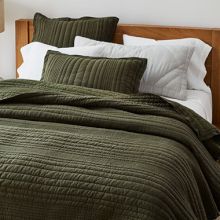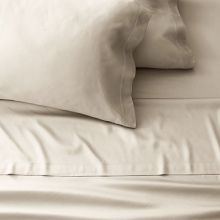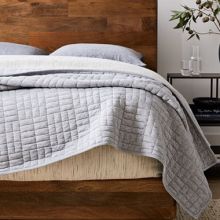Related Categories
What is a Duvet Cover?
Choosing the right bedding for you can make all the difference in sleep quality. In colder climates, outer bedding like duvets is both beautiful and functional. Soft and warm, duvets can make you feel like you're going to sleep in a fluffy, comfortable cloud. Once you find the right one for you, it's also important to practice good care and maintenance. Here's a primer on this essential bedding accessory.
Do You Need a Duvet Cover?
In extra-cold weather, duvets are second to none in providing a good sleeping or lounging experience. Imagine a quilt or a plastic enclosure packed to plush perfection with fill like feathers, foam or down. This loose fill gives duvets an unparalleled advantage over other types of bedding: lightweight and effective heat insulation.
Unlike comforters, however, duvets don't come with their own protective fabric layer. Much like a pillow needs a case for proper everyday use, a duvet calls for a duvet cover to keep it draped. Duvet covers are essential accessories for anyone who already owns or is considering purchasing a duvet insert for their home.
What Materials are Duvet Covers Made From?
Duvet covers come in a wide variety of fabric and fibers. The most common type you'll find at West Elm are cotton duvet covers. Cotton is a highly attractive fabric for bedding because it allows for increased breathability, which keeps your duvet fresh. Other options for materials include both natural and synthetic fibers like Belgian flax linen, flannel, silk, tencel and velvet. For maximum comfort and quality, look for high-thread counts.
The Benefits of Using a Duvet Cover
Duvet covers are the first line of defense to ensure your duvet insert lasts a long time. They protect your duvet against dust and accidental spills so you can enjoy a pristine sleeping environment.
Another undeniable benefit to duvet covers is the sheer versatility they provide. Outer bedding like comforters come in one determined, unchangeable pattern. Duvet covers, on the other hand, allow you to customize your bedroom decor. Because duvet covers come in a wide range of colors and materials, you can completely transform your bedding in a matter of minutes without having to purchase several duvets to take up your closet space.
Further, you can also use duvet covers on their own―that is, without first slipping them over your duvet―to double as sheets. Compact and lightweight, duvet covers keep you snug and cozy throughout your rest.
Lastly, duvet covers are very easy to clean. Duvet inserts are bulky, making the prospect of washing them impractical. Duvet covers, on the other hand, are hassle-free. In just a few minutes, you can slip the current cover off and encase your duvet in a fresh new one. Many duvet covers are machine washable, too, which is a welcome advantage for the modern homeowner.
Choosing a Duvet Cover
The first order of business is to make sure you get the right size duvet cover. Duvet covers don't always conform to conventional sizing like king, queen, twin and single. If you're in doubt, take accurate measurements of your duvet and look at the sizing chart to find the closest match.
The fit is a balancing act. Ideally, your duvet cover will be loose enough so you can put them on without a fuss. All the same, they should also not be so loose that your duvet ends up sliding around inside the cover.
Steps to Put on a Duvet Cover
Putting on a duvet cover can seem like a tricky business, but it's surprisingly easy. Just follow these simple steps and it'll be a breeze.
1. Spread your duvet on a flat surface, like on top of your bed.
2. Turn your duvet cover inside out.
3. Slide your arms inside the duvet cover until you find the top corners on the opposite of the opening. By this point, your arms should be encased in the duvet cover.
4. With your hands still holding the corners of the duvet cover from the inside, reach toward the duvet itself and grab two corners of it.
5. With a firm grip on the corners of your duvet, slide the duvet cover around your arms down the duvet itself. As you do so, the cover will no longer be inside out.
6. Once you've slipped a portion of the cover on, give the cover a good shake until the duvet is firmly inside.
How to Care for Your Duvet
Change the duvet cover as regularly as you change your other bedding and sheets. When it's time to wash, follow the instructions from the manufacturer. It's always a good idea to use neutral cleaning products and gentle solutions for your bedding.
Arguably the most helpful benefit of a duvet cover is that it significantly cuts down on care and maintenance for the duvet insert itself. With this guide to help you find the right cover, your duvet will be dressed and protected in no time.



